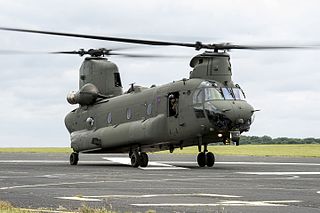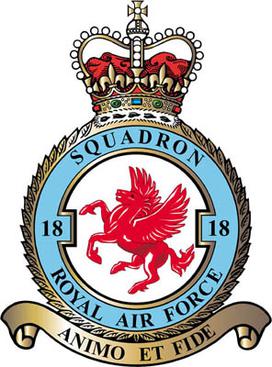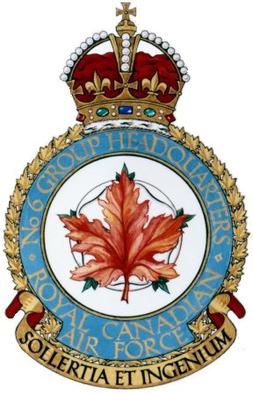
The Desert Air Force (DAF), also known chronologically as Air Headquarters Western Desert, Air Headquarters Libya, the Western Desert Air Force, and the First Tactical Air Force (1TAF), was an Allied tactical air force created from No. 204 Group RAF under RAF Middle East Command in North Africa in 1941 to provide close air support to the British Eighth Army against Axis forces. Throughout the Second World War, the DAF was made up of squadrons from the Royal Air Force (RAF), the South African Air Force (SAAF), the Royal Australian Air Force (RAAF), the United States Army Air Forces (USAAF) and other Allied air forces.

RAF Odiham is a Royal Air Force station situated a little to the south of the village of Odiham in Hampshire, England. It is the home of the Royal Air Force's heavy lift helicopter, the Chinook, and of the King's Helicopter Flight (TKHF). Its current station commander is Group Captain Donal McGurk.

The Westland Lysander is a British army co-operation and liaison aircraft produced by Westland Aircraft that was used immediately before and during the Second World War.

Royal Air Force Tangmere or more simply RAF Tangmere is a former Royal Air Force station located in Tangmere, England, famous for its role in the Battle of Britain.

No. 4 Squadron, normally written as IV Squadron, of the Royal Air Force operates the BAE Hawk T2 in the training role from RAF Valley.
Operation Jubilee was the Allied code name for the raid at Dieppe on the French coast on August 19, 1942. The following order of battle lists the significant military units that participated in the battle, or were available as reserve.

No. 18 Squadron of the Royal Air Force operates the Boeing Chinook from RAF Odiham. Owing to its heritage as a bomber squadron, it is also known as No. 18 (B) Squadron.

RAF Andover is a former Royal Flying Corps and Royal Air Force station in England, 2 miles (3.2 km) west of Andover, Hampshire. As well as RFC and RAF units, units of the Aviation Section, U.S. Signal Corps, Royal Canadian Air Force, United States Army Air Forces, and the Air Transport Auxiliary were also stationed at the airfield.

Canadian Forces Base Greenwood, or CFB Greenwood, is a Canadian Forces Base located 1.5 nautical miles east of Greenwood, Nova Scotia. It is primarily operated as an air force base by the Royal Canadian Air Force and is one of two bases in the country using the CP-140 Aurora and CP-140A Arcturus anti-submarine/maritime patrol and surveillance aircraft. Its primary RCAF lodger unit is 14 Wing, commonly referred to as 14 Wing Greenwood.

No. 6 Group RCAF was a group of Royal Canadian Air Force (RCAF) heavy bomber squadrons in Europe during the Second World War, between 1942 and 1945. The group operated out of airfields in Yorkshire, England.

No. 26 Squadron of the Royal Air Force was formed in 1915 and was disbanded for the last time in 1976.

Royal Air Force Bottisham or more simply RAF Bottisham is a former Royal Air Force station located 5 miles (8 km) east of Cambridge, Cambridgeshire, England.

Redhill Aerodrome is an operational general aviation aerodrome located 1.5 NM south-east of Redhill, Surrey, England, in green belt land.

Old Sarum Airfield is a grass strip airfield 2 nautical miles north-north-east of Salisbury, Wiltshire, England.

404 Long Range Patrol and Training Squadron is a long range patrol and training squadron in the Royal Canadian Air Force. The squadron was originally No. 404 Squadron of the Royal Canadian Air Force (RCAF) and later the Canadian Forces Air Command.
No. 240 Operational Conversion Unit RAF is a former Royal Air Force Operational conversion unit which was formed by a series of mergers, it then became No. 27 Squadron RAF in 1993.

Alan Charles Rawlinson, was an Australian airman who became a fighter ace in World War II. He was credited with at least eight aerial victories, as well as two aircraft probably destroyed, and another eight damaged.
No. 128 Wing RAF is a former Royal Air Force wing that was operational during both the Second World War and the Cold War.
No. 129 Wing RAF is a former Royal Air Force wing that was operational during the Second World War.














